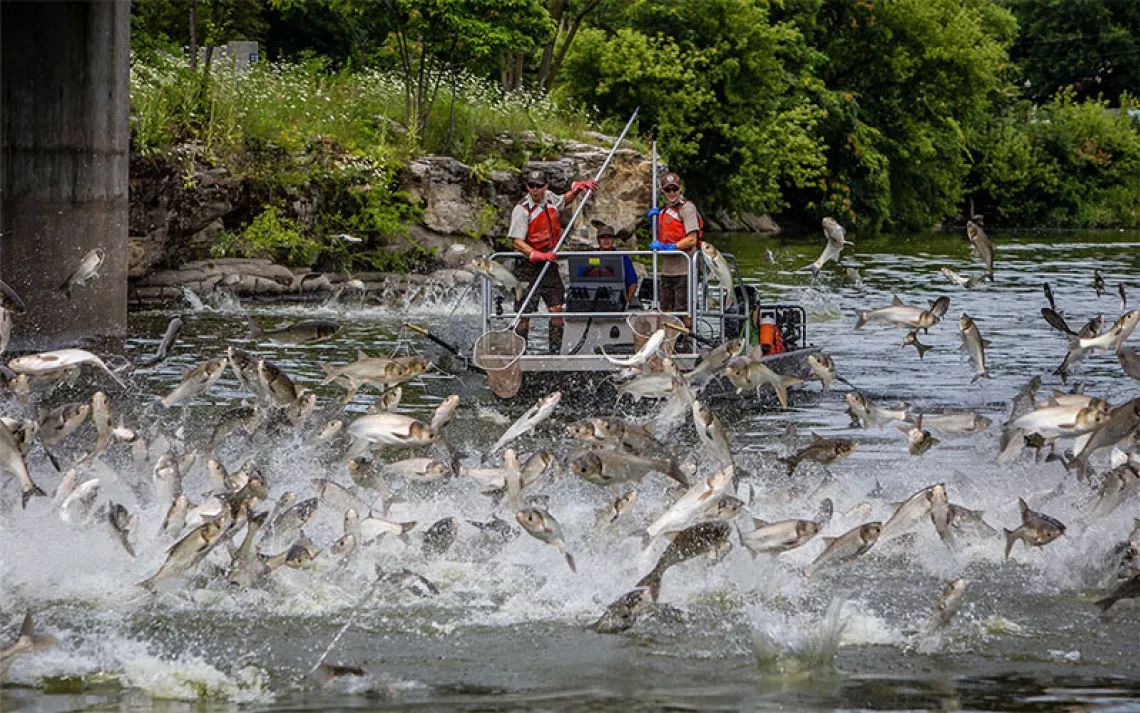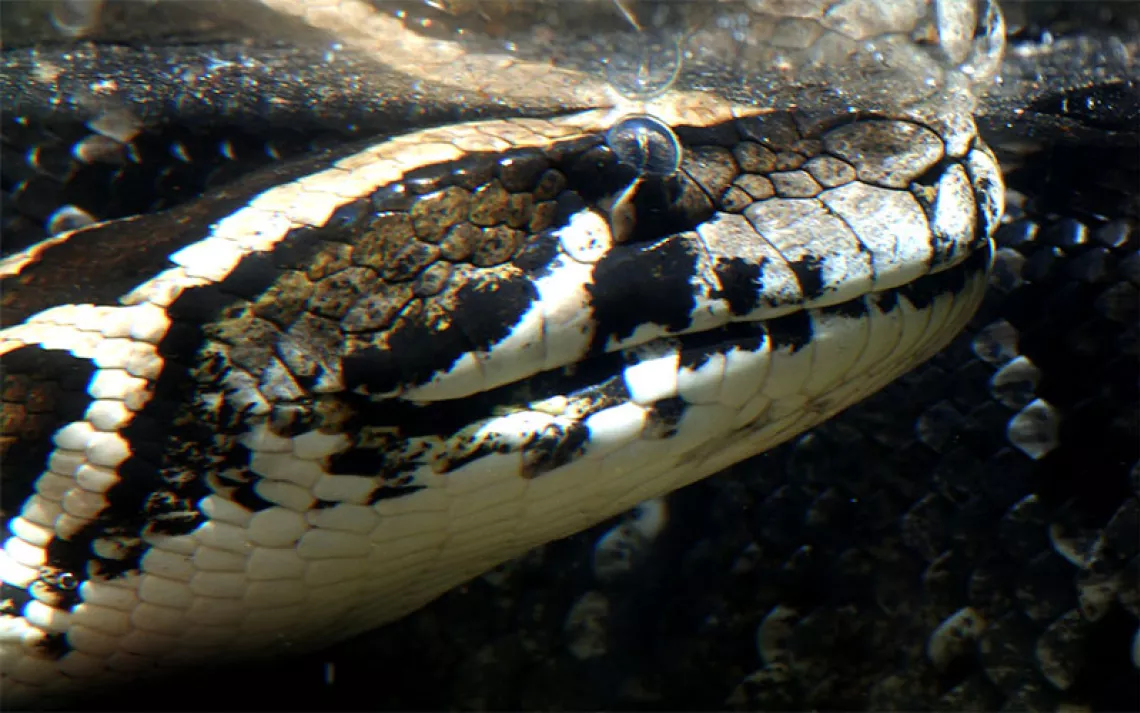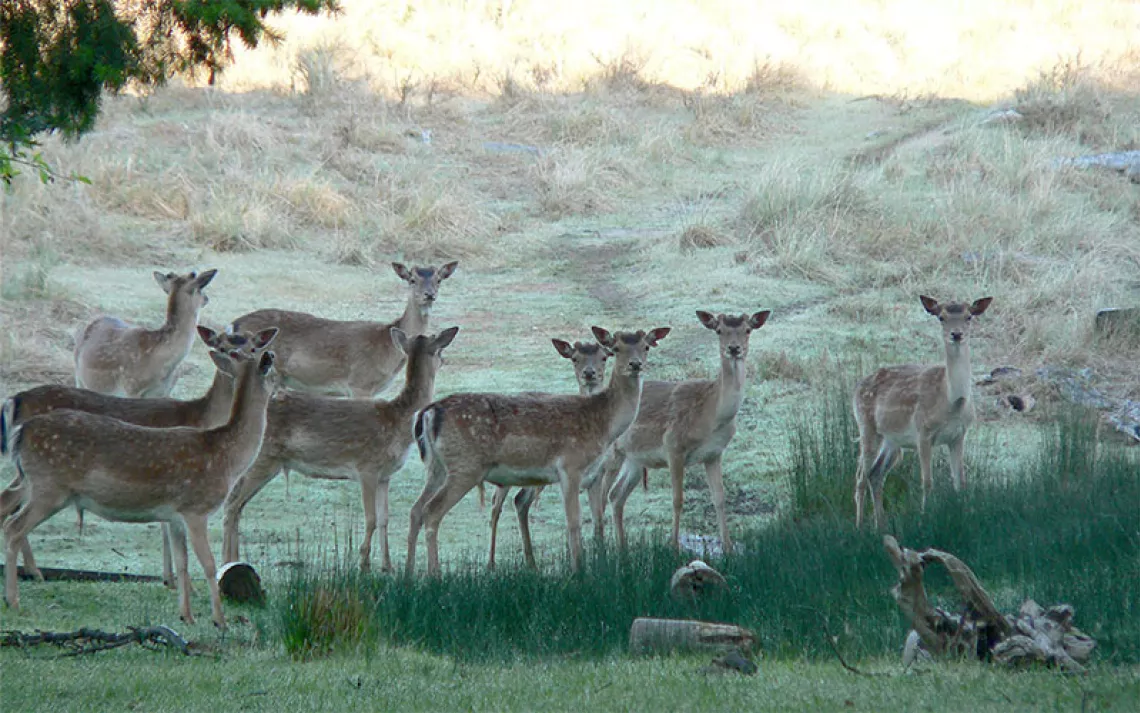Meet the Invasive-Species Squad
Purging prolific garlic mustard unites this cul-de-sac community

Photos courtesy of Amy Brecount White
“Oh no!” I called out to my neighbors, who stood about 30 feet away in a park that sits behind our homes in Arlington, Virginia. “There’s a whole 'nother colony here.”
Jeff, Suzanne, and Julia all murmured sympathetically, without interrupting their steady bend-and-pull motions. As members of our cul-de-sac’s core invasive-species squad, we were on a unified mission to eradicate as many garlic mustard plants (Alliaria petiolata) as possible before they bloomed in late April and May and flung their abundant seeds throughout our woods.
 Over the two decades that I’ve lived adjacent to a tributary of Donaldson Run and its surrounding woods in Arlington County, I, along with my squad, have learned a lot about what’s at risk. This poor urban stream of ours has been decimated by stormwater runoff, extreme rain events (and their attendant erosion and tree falls), and an influx of aggressive invasive plant species. Invasive plants such as garlic mustard, porcelain berry, and kudzu can proliferate and crowd out native plants and saplings, and also threaten large trees. Without native plants to support them, many native species of insects, butterflies, and birds will, in turn, find our woods inhospitable. The whole ecosystem can get out of whack, which means the quality of our water and air could be at risk too.
Over the two decades that I’ve lived adjacent to a tributary of Donaldson Run and its surrounding woods in Arlington County, I, along with my squad, have learned a lot about what’s at risk. This poor urban stream of ours has been decimated by stormwater runoff, extreme rain events (and their attendant erosion and tree falls), and an influx of aggressive invasive plant species. Invasive plants such as garlic mustard, porcelain berry, and kudzu can proliferate and crowd out native plants and saplings, and also threaten large trees. Without native plants to support them, many native species of insects, butterflies, and birds will, in turn, find our woods inhospitable. The whole ecosystem can get out of whack, which means the quality of our water and air could be at risk too.
Technically, these woods belong to the people of Arlington County, but our squad has been invited to act as stewards of the land. While county officials have successfully targeted and curbed the spread of kudzu and Asian wisteria, they made a point of asking local volunteers to help eradicate garlic mustard.
“Because garlic mustard is an annual, repeated hand pulling in the spring before it goes to seed can be very effective at controlling it,” says Christin Jolicoeur, senior watershed planner for Arlington County’s Department of Environmental Science. “It’s also easy to pull, making it a plant that can be tackled by volunteers with a wide range of ages and abilities. This sets it apart among non-native invasive plants, which often have extensive underground root systems and are difficult to tackle without herbicides.”
About 10 years ago, I coordinated with Jolicoeur and another county expert who came out to our woods and showed an assembled group of 12 what to pull as we tackled the overrun-by-invasive-species hillside of an elderly neighbor’s property.
“That was strangely satisfying,” one newbie neighbor told me afterward. I wholeheartedly agreed.
Tackling garlic mustard does require diligence and dedication. In its second year of life (it’s a biennial), one lone garlic mustard plant can produce up to 868 seeds, according to the Southeast Exotic Pest Plant Counsel. The plant thrives even in full shade and can take over the understory of a wooded area in record time, thus displacing native wildflowers such as spring beauty, toothwort (important for some native butterflies), and trillium. The plant also spreads its toxicity by releasing allelopathic compounds that can suppress the seedling growth of native trees and plants. Nationwide, garlic mustard is found in 38 states.
First introduced to the US in the 1800s by European settlers, garlic mustard was valued for its medical and culinary uses. Some modern foragers still find its heart-shaped green leaves to be tasty; however it should only be enjoyed in limited quantities because the plant contains traces of cyanide. In Europe, the species has natural predators, which keep its propagation superpowers in check, but here, not even the deer will eat it. If we’re not vigilant, my neighbors and I know that within a few years, our beloved park could become a monoculture of garlic mustard rather than the lovely, biodiverse urban woods we imagine it can be.
Ever since we coordinated our extrication efforts, I’ve spotted other types of native species—spicebush, mayapples, and jewelweed—thriving along our paths. Our mission keeps growing ever more urgent—and more timely too. For several reasons, including the health of the nearby Chesapeake Bay, Arlington County plans to restore our section of the stream later this year and also to replant native trees and bushes, which will stabilize the banks and help prevent future erosion. In anticipation, we’ve upped our efforts against garlic mustard and other invasives, like English ivy, which creeps up and endangers trees. Clearing them prior to restoration will help provide open and fertile ground for when the county replants native species.
We’ve found that the best time to pull garlic mustard (it does smell lightly of garlic if you crush the leaves) is after a soaking rain. You want to bend and grab the plant low on its stem to make sure you get the sometimes-carrot-size root. Amid spring’s bright greenery, the telltale clusters of tiny white flowers make the plants easy to spot.
 Tackling such woodland invaders solo, though, can feel quixotic. Which is why many parks and municipalities across the nation coordinate group pulls. Arlington County calls them RIPs (for “removing invasive plants”) and sponsors several a year.
Tackling such woodland invaders solo, though, can feel quixotic. Which is why many parks and municipalities across the nation coordinate group pulls. Arlington County calls them RIPs (for “removing invasive plants”) and sponsors several a year.
Our squad’s desire to support native populations in the woods has also led us to choose more native species for our own yards. I routinely exchange native pines, dogwoods, and wood poppies with my neighbors. When a new family moved in, I welcomed them with a native spicebush to plant in their woods. This past year, I also bought and distributed milkweed seed packets (which monarch butterflies require) to plant in the sunnier spots at the edge of our woods. I want my still-hypothetical grandchildren to see butterflies when they visit my thriving garden and stroll along the stream.
On a weekend earlier in May when the telltale white, four-petalled flowers appeared on the stalks, our squad gathered with gloves and black trash bags to pull out all the garlic mustard we could find. The clock, of course, was ticking—we wanted to extricate them before they could reseed, and we needed all the help we could muster.
To learn how to identify and pull garlic mustard, ask your local park authority or watch this video from the Chicago Botanic Garden.
 The Magazine of The Sierra Club
The Magazine of The Sierra Club



